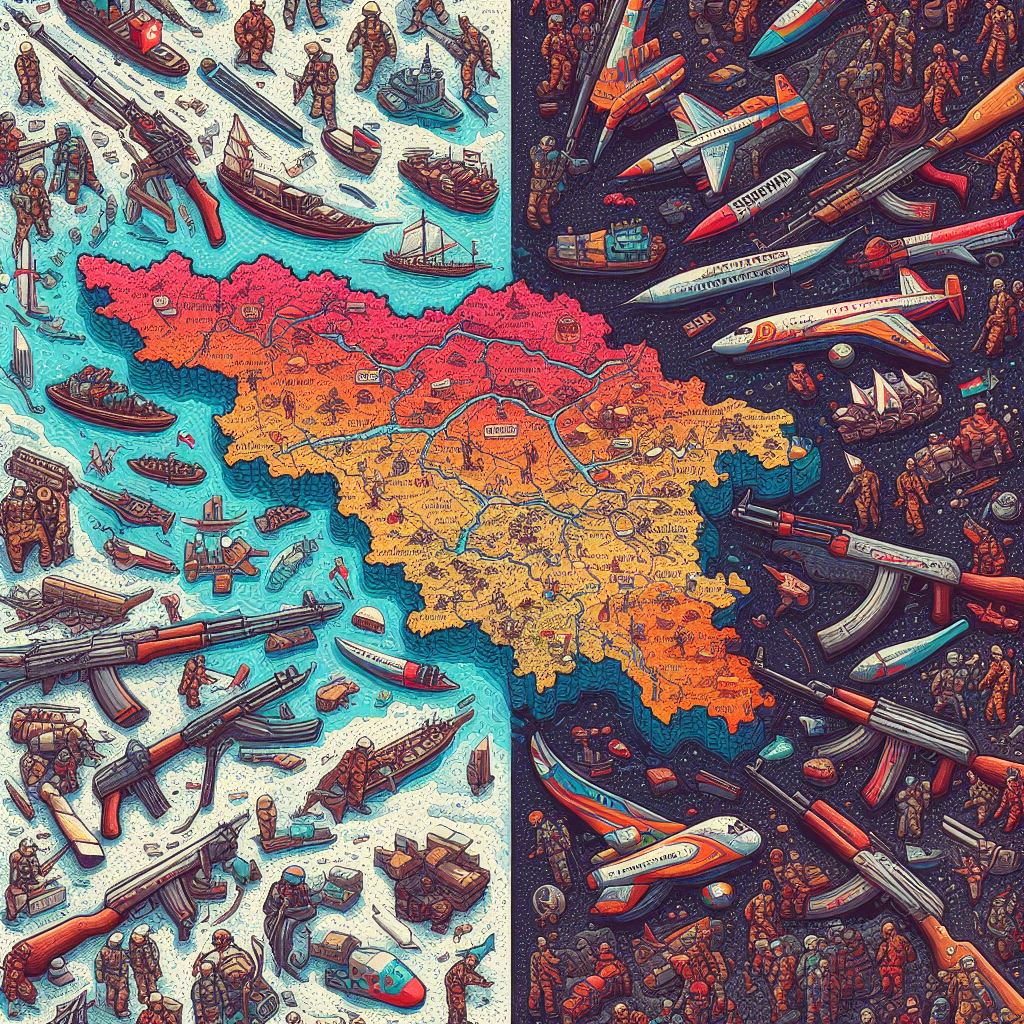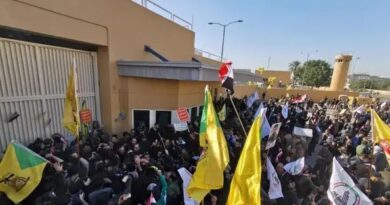The Nagorno-Karabakh Conflict: A Brief Overview
The Nagorno-Karabakh conflict is a dispute between Armenia and Azerbaijan over a mountainous region that is internationally recognized as part of Azerbaijan but populated and controlled by ethnic Armenians. The conflict dates back to the Soviet era, when the region was granted autonomy within Soviet Azerbaijan. The conflict escalated into a full-scale war in the late 1980s and early 1990s, and remains unresolved despite several ceasefires and mediation efforts. The conflict challenges the principles of territorial integrity and self-determination in international law.

On September 19, 2023, Azerbaijan launched a surprise military offensive against the Armenian forces in Nagorno-Karabakh, claiming to restore its sovereignty over the region. The attack was met with fierce resistance from the Armenian side, but Azerbaijan quickly gained ground with the help of Turkish drones, mercenaries, and artillery. The fighting lasted for a day and resulted in hundreds of casualties on both sides, as well as widespread destruction of civilian infrastructure and cultural heritage.
On September 20, 2023, Russia brokered a ceasefire agreement between Armenia and Azerbaijan, which stipulated that the Armenian forces would lay down their arms and withdraw from Nagorno-Karabakh, while Azerbaijan would guarantee the safety and rights of the remaining Armenian population. The agreement also stated that Nagorno-Karabakh would cease to exist as a self-proclaimed republic from January 1, 2024, and that its future status would be determined by negotiations between Armenia and Azerbaijan under the auspices of the OSCE Minsk Group.
However, the ceasefire agreement was met with outrage and protests by many Armenians, who saw it as a betrayal and a surrender. More than 68,000 people have fled from Nagorno-Karabakh to Armenia since the start of the Azerbaijani offensive, fearing for their lives and their homeland. Many of them have lost their relatives, friends, homes, and belongings in the war. Some have vowed to return and fight for their land, while others have expressed despair and hopelessness.
The Geopolitical Reasons Behind the Conflict
The conflict over Nagorno-Karabakh has geopolitical underpinnings. Nagorno-Karabakh’s regional parliament voted to become part of Armenia when the Soviet Union began to collapse, leading to ethnic clashes and a full-scale war. The conflict is centered around the geopolitical feature of territorial integrity/consensus on agreed upon borders versus self-determination. The conflict is of high geopolitical importance due to its proximity to strategic oil and gas pipelines and its location between the powerful regional forces of Russia, Turkey, and Iran. These nations could be drawn into the conflict and its rising death toll.
Turkey has been a staunch ally and supporter of Azerbaijan since its independence in 1991. Turkey shares ethnic, linguistic, cultural, and religious ties with Azerbaijan, as well as strategic interests in the Caspian Sea region. Turkey has provided Azerbaijan with military assistance, training, equipment, intelligence, and diplomatic backing in its conflict with Armenia. Turkey has also been accused of sending Syrian mercenaries to fight alongside Azerbaijani forces in Nagorno-Karabakh.
Russia has been a traditional protector and partner of Armenia since the 19th century. Russia has a military base in Armenia and both countries are members of the Collective Security Treaty Organization (CSTO), a regional security alliance. Russia has also been a co-chair of the OSCE Minsk Group since 1992, along with France and the United States. Russia has tried to balance its relations with both Armenia and Azerbaijan, selling weapons to both sides and mediating several ceasefires in the past. However, Russia’s intervention in Ukraine in 2022 has strained its ties with Armenia and weakened its influence in the region.
Iran has a complex and ambivalent position on the Nagorno-Karabakh conflict. On one hand, Iran has a sizable ethnic Azerbaijani minority within its borders, which constitutes about 16% of its population. Iran also has economic ties with Azerbaijan, especially in the energy sector. On the other hand, Iran has historical and religious links with Armenia, which is one of the oldest Christian nations in the world. Iran also fears Turkish expansionism and interventionism in its neighborhood. Iran has called for a peaceful resolution of the conflict based on international law and respect for territorial integrity.
The Global Impacts of the Conflict
The conflict over Nagorno-Karabakh has global impacts on various levels: humanitarian, security, energy, cultural, and legal.
The humanitarian impact of the conflict is devastating. According to official sources from both sides, more than 7,000 people have been killed in the war since 2020¹, including civilians and soldiers. More than 100,000 people have been displaced from their homes², facing harsh conditions and trauma. Many people have also suffered from injuries, diseases, hunger, poverty, and human rights violations.
The security impact of the conflict is alarming. The conflict poses a threat to regional stability and international peace, as it could trigger a wider war involving external actors. The conflict also increases the risk of terrorism, extremism, and radicalization, as some groups may exploit the situation to advance their agendas. The conflict also undermines the efforts to prevent the proliferation of weapons of mass destruction, as both Armenia and Azerbaijan have been accused of using banned weapons such as cluster munitions and phosphorus bombs.
The energy impact of the conflict is significant. The conflict affects the supply and transit of oil and gas from the Caspian Sea region to Europe and beyond. The region hosts several major pipelines, such as the Baku-Tbilisi-Ceyhan (BTC) oil pipeline, the South Caucasus Pipeline (SCP) gas pipeline, and the Trans-Anatolian Natural Gas Pipeline (TANAP) gas pipeline. These pipelines have been targeted by both sides during the war, causing damage and disruption. The conflict also affects the exploration and development of new energy resources in the Caspian Sea, which holds about 10% of the world’s proven oil reserves and 15% of its gas reserves³.
The cultural impact of the conflict is tragic. The conflict has resulted in the destruction and desecration of many cultural and religious sites in Nagorno-Karabakh, which has a rich and diverse heritage. The region is home to ancient monasteries, churches, mosques, temples, fortresses, palaces, and monuments that reflect the history and identity of different civilizations and faiths. Many of these sites have been damaged or demolished by shelling, bombing, looting, vandalism, or arson. Some of these sites are also on the UNESCO World Heritage List or Tentative List⁴.
The legal impact of the conflict is challenging. The conflict raises many legal questions and dilemmas regarding the application and interpretation of international law. The conflict involves issues such as the right to self-determination, the principle of territorial integrity, the use of force, the protection of civilians, the respect for human rights, the preservation of cultural heritage, and the responsibility to protect. The conflict also tests the effectiveness and legitimacy of international institutions and mechanisms that are supposed to prevent and resolve conflicts peacefully.
Some Facts and Data About the Nagorno-Karabakh Conflict
Here are some facts and data about the Nagorno-Karabakh conflict that may help you understand it better:
– Nagorno-Karabakh means “mountainous black garden” in Turkish⁵.
– The population of Nagorno-Karabakh before the 2023 war was about 120,000 people⁶, mostly ethnic Armenians (95%) and some ethnic Azerbaijanis (4%).
– The area of Nagorno-Karabakh is about 4,400 square kilometers (1,700 square miles)⁷, slightly larger than Rhode Island or Luxembourg.
– The capital of Nagorno-Karabakh is Stepanakert⁸, which was named after Stepan Shaumian, a Bolshevik leader who was executed by British forces in 1918.
– The currency of Nagorno-Karabakh is the Armenian dram⁹, which is also used in Armenia.
– The flag of Nagorno-Karabakh is based on the flag of Armenia[^10^], but with a white pattern that represents a traditional Armenian carpet.
– The anthem of Nagorno-Karabakh is “Azat u ankakh Artsakh” (“Free and Independent Artsakh”)¹¹, which is also the motto of the republic.
– The religion of Nagorno-Karabakh is mainly Armenian Apostolic Christianity¹², which is one of the oldest branches of Christianity in the world.
– The language of Nagorno-Karabakh is Armenian¹³, which belongs to an independent branch of the Indo-European language family.
– The culture of Nagorno-Karabakh is influenced by Armenian, Persian, Turkish, Russian, and Caucasian traditions¹⁴. It is known for its music, literature, art, cuisine, and festivals.
The Nagorno-Karabakh conflict is a complex and multifaceted issue that has profound implications for regional and global affairs. It is not only a matter of territorial dispute between two neighboring countries, but also a matter of identity, history, culture, religion, geopolitics, security, energy, law, and human dignity. It is a conflict that has caused immense suffering and loss for millions of people on both sides. It is a conflict that needs urgent attention and action from the international community to prevent further escalation and violence. It is a conflict that requires dialogue and cooperation to find a lasting and peaceful solution that respects the rights and interests of all parties involved.
References
¹: [Nagorno-Karabakh: Death toll rises amid Azerbaijan-Armenia fighting](https://www.bbc.com/news/world-europe-54338454)
[^2
Source: Conversation with Bing, 06/10/2023
(1) Illini Journal of International Security » Blood Feud: The Nagorno …. https://publish.illinois.edu/illinijournalofinternationalsecurity/blog/blog-spring-2016/blood-feud-the-nagorno-karabakh-conflict/.
(2) . https://bing.com/search?q=Nagorno-Karabakh+conflict.
(3) Nagorno-Karabakh conflict – Wikipedia. https://en.wikipedia.org/wiki/Nagorno-Karabakh_conflict.
(4) Nagorno-Karabakh: Conflict between Azerbaijan and Armenians … – BBC. https://www.bbc.com/news/world-europe-66852070.
(5) Armenia-Azerbaijan: Why did Nagorno-Karabakh spark a conflict?. https://www.bbc.com/news/world-europe-54324772.
(6) Armenia–Azerbaijan relations – Wikipedia. https://en.wikipedia.org/wiki/Armenia%E2%80%93Azerbaijan_relations.
(7) What’s behind the conflict over Nagorno-Karabakh? – DW. https://www.dw.com/en/whats-behind-the-conflict-over-nagorno-karabakh/a-66951971.
(8) . https://bing.com/search?q=geopolitical+reasons+behind+Nagorno-Karabakh+conflict.
(9) Event Report on the Geopolitical Implications of the War in Nagorno …. https://www.fpri.org/article/2020/10/event-report-on-the-geopolitical-implications-of-the-war-in-nagorno-karabakh/.
(10) How the Nagorno-Karabakh conflict has been shaped by past empires. https://www.nationalgeographic.co.uk/history-and-civilisation/2020/10/how-the-nagorno-karabakh-conflict-has-been-shaped-by-past-empires.
(11) Geopolitics of the Nagorno-Karabakh War | Geopolitical Monitor. https://www.geopoliticalmonitor.com/geopolitics-of-the-nagorno-karabakh-war/.
(12) Azerbaijan’s Strategic Manoeuvre: Analysing the Nagorno-Karabakh Conflict’s Global Impact. https://www.financialexpress.com/world-news/azerbaijans-strategic-manoeuvre-analysing-the-nagorno-karabakh-conflicts-global-impact/3261499/.
(13) Nagorno-Karabakh: How the conflict is affecting global energy dynamics. https://www.thenationalnews.com/business/comment/2023/10/02/nagorno-karabakh-how-the-conflict-is-affecting-global-energy-dynamics/.
(14) CENUSA: The forced dissolution of northern Karabakh and lessons for resolving the “frozen conflict” in Moldova. https://www.bne.eu/cenusa-the-forced-dissolution-of-northern-karabakh-and-lessons-for-resolving-the-frozen-conflict-in-moldova-295420/.
(15) Nagorno-Karabakh Conflict | Global Conflict Tracker. https://www.cfr.org/global-conflict-tracker/conflict/nagorno-karabakh-conflict?trk=public_post_comment-text.
(16) Nagorno-Karabakh: the world should have seen this crisis coming – and …. https://theconversation.com/nagorno-karabakh-the-world-should-have-seen-this-crisis-coming-and-its-not-over-yet-214663.
(17) The Historical Background to the Continuing Conflict Over Nagorno-Karabakh. https://link.springer.com/chapter/10.1007/978-3-031-16262-6_2.
(18) The Nagorno-Karabakh Conflict | CSCE. https://www.csce.gov/international-impact/publications/nagorno-karabakh-conflict.
(19) . https://bing.com/search?q=facts+and+data+about+Nagorno-Karabakh+conflict.
(20) Nagorno-Karabakh Conflict | Global Conflict Tracker. https://www.cfr.org/global-conflict-tracker/conflict/nagorno-karabakh-conflict.
(21) Armenia-Azerbaijan conflict: Casualties mount in Nagorno-Karabakh … – BBC. https://www.bbc.com/news/world-europe-54338454.



